Introduction
If you're interested in trading the foreign exchange market, understanding the fundamental analysis of currency pairs is crucial. One popular pair to study is the NZD/USD, which represents the New Zealand dollar against the US dollar.
The NZD/USD currency pair shows the exchange rate between the New Zealand Dollar (NZD) and the US Dollar (USD). Traders and investors around the world pay close attention to this pair due to the economic importance of both countries and the influence of global events on their currencies.
The New Zealand Dollar, also known as the Kiwi, is the official currency of New Zealand and is heavily influenced by the country's agricultural and export sectors. The U.S. dollar, on the other hand, serves as the world's primary reserve currency, and its value is influenced by the strength of the U.S. economy and global financial markets.
In this article, we'll explore the importance of fundamental analysis and provide a brief overview of both currencies.
Macroeconomic Overview - New Zealand

Image Source: Unsplash
When delving into the fundamental analysis of the NZD/USD currency pair, it is important to understand the macroeconomic landscape of New Zealand. These factors have a significant impact on the exchange rate between the New Zealand Dollar (NZD) and the US Dollar (USD).
Let's examine the main economic indicators, monetary policy, and political climate of New Zealand that significantly influence the performance of the New Zealand Dollar (NZD).
A. Economic Indicators Review
Over the past four years, New Zealand's economy has shown resilience with consistent GDP growth. In 2020, despite the challenges posed by the global pandemic, the country's GDP contracted by 2.9%. However, the recovery was swift, and by 2021, GDP had bounced back at an impressive rate of 5.3%. This positive momentum continued into 2022, with a growth rate of 3.8%, signaling a steady economic expansion. Forecasts for 2023 point to a further growth rate of 2.5%, fostering a favorable environment for the NZD.
Accordingly, New Zealand's unemployment rate showed a downward trend during this period. In 2020, the rate peaked at 4.2% due to pandemic-related job losses. However, as economic activity resumed, unemployment fell to 3.7% in 2021 and further to 3.2% in 2022. For 2023, experts predict a slight increase to 3.5%, which remains relatively low and bodes well for the economy.
The country experienced moderate inflation during these years, remaining within the target range set by the Reserve Bank of New Zealand (RBNZ). In 2020, inflation was subdued at 1.4%, largely due to reduced consumer spending amid pandemic uncertainties. However, it rebounds to 2.5% in 2021 and stabilizes at 2.2% in 2022. The forecast for 2023 shows a slight decline to 2.0%, reflecting a stable price environment.
Business and consumer confidence play a key role in shaping the economic outlook. In the aftermath of the pandemic, both indicators showed a gradual recovery. Business sentiment improved from negative territory in 2020 to positive levels as entrepreneurs adapted to new realities and gained confidence in economic stability. Consumer confidence also rose steadily, reflecting growing optimism about personal finances and future economic conditions. These positive sentiments supported the NZD's performance against the USD.
B. Monetary Policy

Image Source: Unsplash
The RBNZ takes a proactive approach to monetary policy, aiming to maintain price stability while supporting maximum sustainable employment. To achieve these goals, the central bank regulates interest rates, open market operations, and foreign exchange interventions.
Throughout the period under review, the RBNZ maintained an accommodative policy stance to support economic recovery. The official cash rate (OCR) was cut to historic lows, and forward guidance indicated a patient stance on interest rate adjustments. In 2023, as inflationary pressures eased, the central bank communicated a potential gradual tightening, but the OCR remained below pre-pandemic levels. Such actions impacted the NZD/USD, as interest rate differentials influence exchange rates.
C. Political Climate

Image Source: Unsplash
The New Zealand government focused on infrastructure investment, fiscal support, and innovation during these years. These policies supported economic growth and increased the country's attractiveness for foreign investment, which had a positive impact on the NZD.
New Zealand is known for its open trade policies and actively participates in regional and international trade agreements. These policies have encouraged exports and foreign investment, driving economic growth and potentially strengthening the NZD against the USD.
Macroeconomic Overview - United States
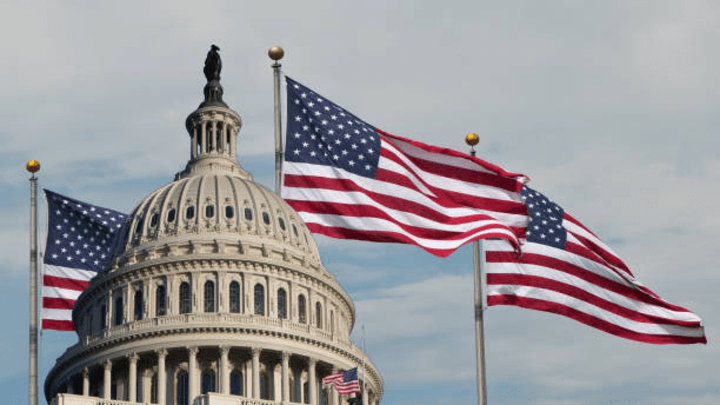
Image Source: Unsplash
In 2023, the United States experienced a strong economic recovery with declining unemployment and subdued inflation. Government stimulus, consumer spending, and business investment fueled growth, while technological advances and infrastructure projects bolstered the outlook. However, policymakers remained vigilant amid international trade tensions, and overcame challenges to maintain the positive momentum.
A. Economic Indicators Review
The U.S. economy experienced a strong rebound in 2022 and 2023, recovering from the pandemic-related slowdown. Gross domestic product (GDP) growth averaged about 3 percent annually, driven by robust consumer spending, increased business investment, and a surge in exports. In addition, the unemployment rate fell to pre-pandemic levels, hovering around 3.5%, indicating a thriving labor market.
In 2022 and 2023, the U.S. faced rising inflationary pressures, largely due to supply chain disruptions and rising commodity prices. The Federal Reserve closely monitored the situation and implemented targeted measures to keep inflation in check while supporting economic growth.
Business and consumer confidence remained high in 2022 and 2023, supported by strong economic performance and government support. High levels of confidence stimulated increased business investment and consumer spending, further contributing to the economic expansion.
B. Monetary Policy
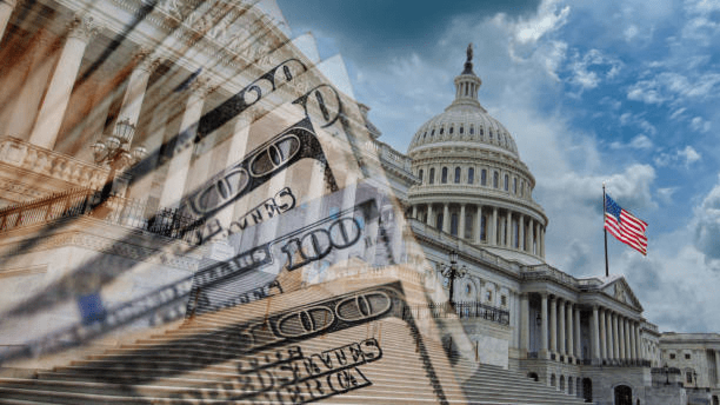
Image Source: Unsplash
The Federal Reserve played a central role in shaping monetary policy during this period. To support the economic recovery, the Fed maintained an accommodative stance, keeping interest rates low and engaging in quantitative easing. The central bank remained committed to its dual mandate of promoting maximum employment and stable prices.
As inflationary pressures intensified, there was speculation that the Federal Reserve might raise interest rates. However, the central bank took a gradual approach, taking into account evolving economic conditions and emphasizing data-driven decisions regarding future rate adjustments.
C. Political Climate

Image Source: Unsplash
In 2022 and 2023, the U.S. government focused on implementing various economic policies to promote sustainable growth and recovery. Fiscal measures aimed at infrastructure development, innovation, and job creation were introduced to support the economy's trajectory.
The U.S. continued to navigate its trade policy during this period. Efforts were made to strengthen existing trade agreements and establish new ones to facilitate international trade and improve the nation's trade balance.
Analysis of the NZD/USD Currency Pair
A. Relevant Economic Indicators
The correlation between the New Zealand and U.S. economies plays an important role in determining the direction of the currency pair. The economic performance of both countries can influence investor sentiment and affect currency flows between the NZD and the USD.
GDP growth, inflation rates, and interest rates are key economic indicators that influence the NZD/USD exchange rate. Positive GDP growth in New Zealand relative to the U.S. can support a stronger NZD against the USD. Differences in inflation rates and interest rate expectations between the two countries can also influence the movement of this currency pair.
B. Factors Supporting a Bullish or Bearish Stance

Image Source: Unsplash
The monetary policy of the Reserve Bank of New Zealand (RBNZ) can affect the NZD/USD exchange rate. If the RBNZ adopts a hawkish monetary policy, signaling potential interest rate hikes to combat inflation, it can strengthen the NZD. Conversely, a dovish stance with accommodative measures may weaken the currency.
Similarly, the Federal Reserve's monetary policy decisions can have a significant impact on the currency pair. A hawkish stance from the Federal Reserve, indicating potential interest rate hikes, may strengthen the USD. On the other hand, a dovish stance focusing on supporting the economic recovery may weaken the USD.
Trade policy, both within New Zealand and on the international stage, can influence the NZD/USD exchange rate. Favorable trade agreements and increased export opportunities can strengthen the NZD, while trade tensions or restrictions can weaken it.
C. Potential Risks to the Currency Pair

Image Source: Unsplash
Any unexpected shifts in global economic growth can cause uncertainty and volatility in the currency markets, including the NZDUSD currency pair. Economic slowdowns or recessions in major economies can cause investors to seek safe-haven assets, affecting the strength of the USD.
Unforeseen policy decisions by either the RBNZ or the Federal Reserve could catch the market off guard and lead to significant currency fluctuations. Central bank communications and signals will be closely watched by investors.
Geopolitical events, such as U.S.-China trade tensions or unexpected global health crises, can create market uncertainty and affect risk sentiment. Investors may turn to safe-haven currencies such as the USD during periods of heightened geopolitical risk.
Trading Strategies for NZDUSD

Image Source: Unsplash
Trading the NZDUSD currency pair successfully requires a well-rounded approach. Combine technical analysis tools such as trend analysis and indicators with effective risk management techniques such as setting stop-loss and take-profit levels and determining appropriate position sizes. In addition, keep an eye on economic events and data releases for news trading opportunities.
A. Technical Analysis
Technical analysis of the NZDUSD involves studying historical price charts, identifying patterns, and using various indicators such as moving averages, RSI, and Fibonacci levels to forecast future price movements. Traders analyze these patterns and trends to make informed trading decisions on the currency pair.
Identifying trends and patterns
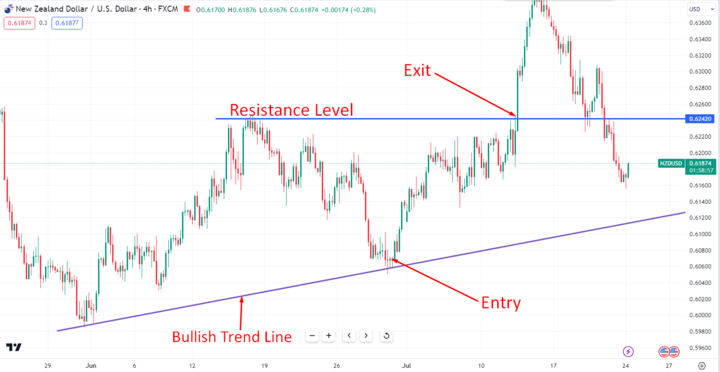
Image Source: TradingView
Technical analysis involves studying historical price data to identify trends and patterns that can help predict future price movements. Look for bullish, bearish and sideways trends on the NZDUSD chart to determine potential entry and exit points.
Use of indicators
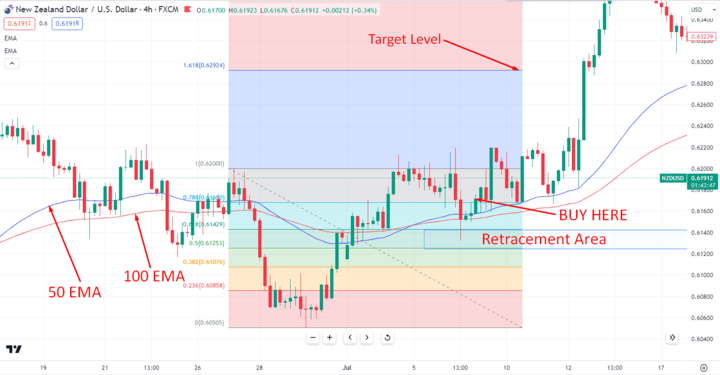
Image Source: TradingView
Moving averages smooth price data and provide valuable insight into the direction of the trend. The combination of 50- and 100-period exponential moving averages can signal potential crossovers, trend reversals, and trend continuation. In addition, Fibonacci retracements can help identify potential support and resistance levels, which can be helpful in determining entry and exit points.
B. Risk Management
Risk management involves the systematic identification, evaluation, and mitigation of potential trading risks. Traders implement strategies such as setting risk tolerance levels, using stop loss orders, diversifying portfolios, and using appropriate position sizes to protect against significant losses.
Setting Stop-Loss and Take-Profit levels
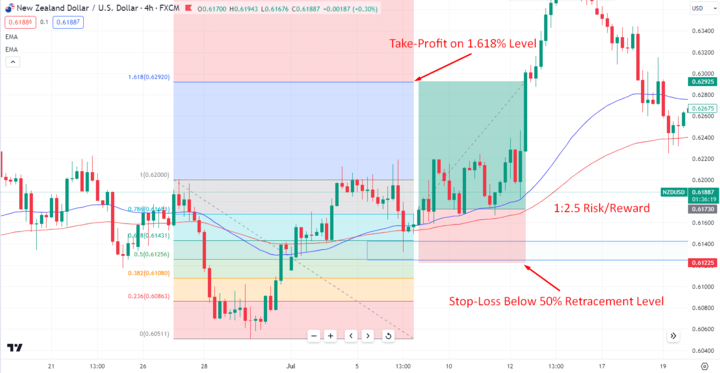
Image Source: TradingView
Always use stop-loss orders to limit potential losses if the trade goes against you. Take-profit orders help to secure profits when the trade reaches a favorable level. Striking a balance between stop-loss and take-profit levels is crucial for risk management.
Determining position size based on risk tolerance
Calculate the appropriate position size for each trade based on your risk tolerance and the distance between your entry and stop loss levels. This will ensure that you don't risk too much of your capital on a single trade.
C. News Trading
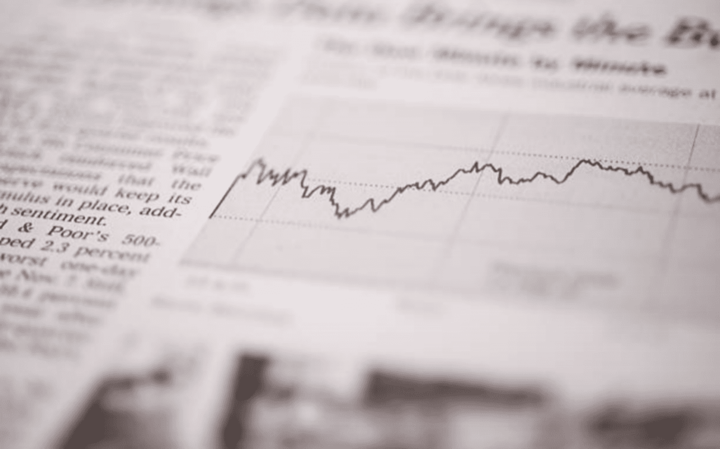
Image Source: Unsplash
News trading is a trading strategy in which traders make decisions based on the influence of major economic news releases, such as GDP data, interest rate decisions, or employment reports. By analyzing these events and anticipating their impact on currency pairs, traders aim to capitalize on potential price movements in the foreign exchange market.
Following economic events and data releases
Stay informed about key economic events and data releases in both New Zealand and the United States. These events can have a significant impact on the NZD/USD exchange rate. Economic indicators such as GDP, employment data, and interest rate decisions are crucial to monitor.
Trading based on market's reactions to the news
After a major news release, watch how the market reacts to the information. Volatility may increase, creating trading opportunities. Be cautious and avoid trading during periods of high uncertainty.
Incorporating VSTAR into your trading journey can provide several advantages, including real-time market data, user-friendly interfaces, and advanced trading tools. The platform's step-by-step guidance and ease of use make it suitable for both beginners and experienced traders. By applying these strategies and utilizing VSTAR's capabilities, you can increase your chances of success in the dynamic world of NZDUSD trading.


Conclusion
In conducting a fundamental analysis of the NZDUSD currency pair, we have examined the economic indicators, monetary policies, and other factors that influence the exchange rate between the New Zealand Dollar (NZD) and the US Dollar (USD). The analysis included monitoring New Zealand's economic performance, trade balance, and commodity prices, as well as considering GDP growth, employment data, and Federal Reserve policy in the United States.
Based on Analysis Based on the latest data from 2022 and 2023, the fundamental analysis suggests a bullish outlook for the NZDUSD currency pair. Favorable economic indicators and rising commodity prices in New Zealand, coupled with supportive Federal Reserve policies in the United States, may drive the NZD/USD exchange rate higher.
Understanding the fundamentals of the NZD/USD currency pair will enable you to navigate the forex market with confidence, capitalize on opportunities as they arise, and achieve success in your trading endeavors.

















